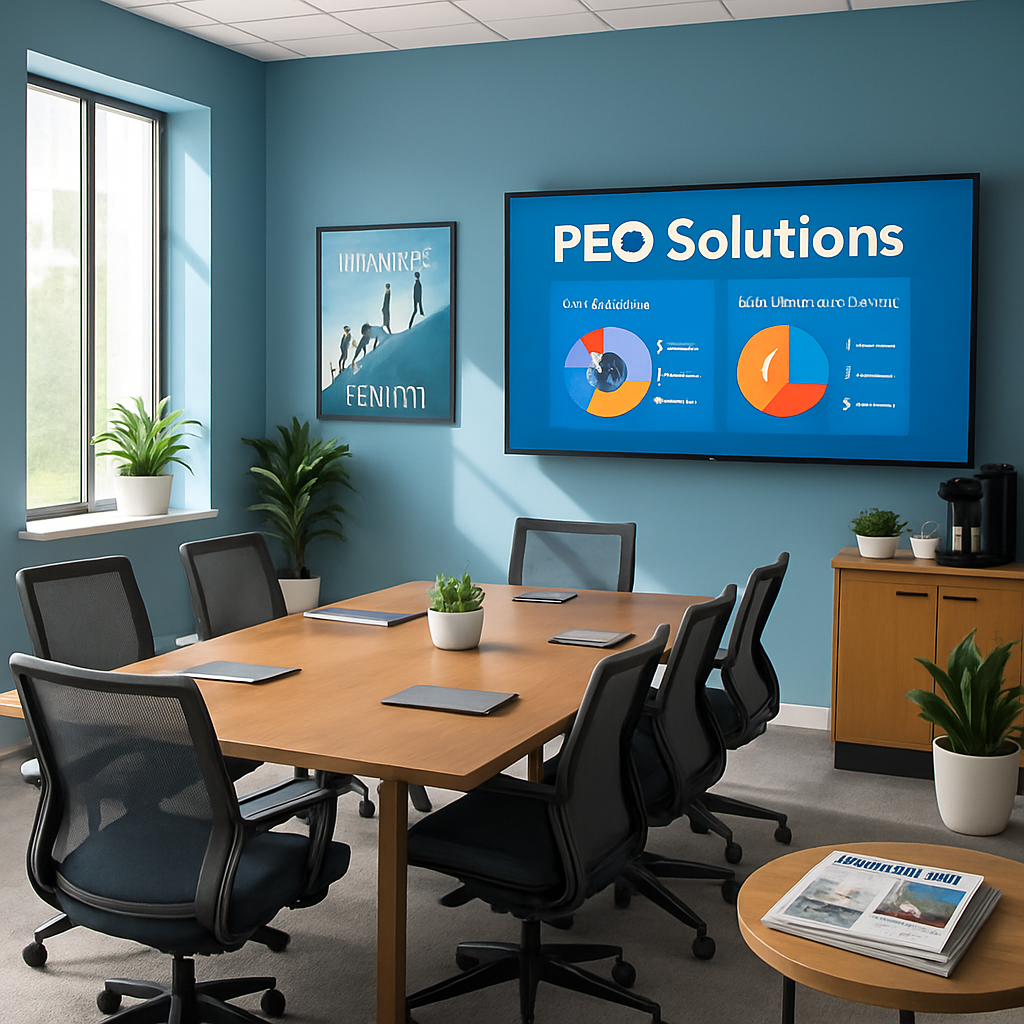- Home /
- The EaseBlog /
The EaseBlog:

Co-Employment Explained: The Game-Changing HR Strategy
Co-employment isn't some newfangled HR fad – it's a time-tested strategy that's helping thousands of companies compete. By sharing employer responsibilities with a partner, businesses can access Fortune 500-caliber benefits, compliance expertise, and other needed resources. Though often misunderstood, these arrangements can significantly empower growing companies.
What is co-employment?
Co-employment is a contractual arrangement where two companies decide to split critical employer obligations and liabilities for a group of employees. Typically, the client company handles day-to-day workforce management while the co-employer takes over administrative HR functions like payroll, benefits, and compliance.
The most common co-employment partnership is between a business and a Professional Employer Organization (PEO). By relying on a PEO's HR expertise and economies of scale, companies can level the playing field against competitors with more resources. It also frees up time for leaders to focus on core priorities rather than HR paperwork.
Many misconceptions about co-employment stem from the fact that PEOs aren't the only ones capable of entering into co-employment agreements. Staffing agencies also have this ability.
What are the two types of co-employment arrangements?
When exploring co-employment agreements, it's essential to understand the two primary arrangements – PEO and staffing agency. Though they share similarities, some key differences impact how responsibilities are divided.
PEO co-employment involves partnering with a Professional Employer Organization that becomes the official "employer of record" for tax and compliance purposes. The PEO oversees administrative HR functions like payroll, benefits, and HR services. This allows the client company to focus on managing and growing their business.
On paper, the PEO becomes the employer of record to remit payroll taxes on your behalf by allowing you to adopt the PEO's federal employer identification number (FEIN). This also gives you access to the PEO's employee benefits master plans, including group health insurance, workers' compensation insurance, dental, vision, disability, and other essential benefits.
Critically, you maintain control of day-to-day decisions such as hiring, firing, work conditions, and supervising employees. The PEO simply handles backend HR administration for the existing permanent workforce. There is no disruption to the client's leadership or operations.
Staffing agency co-employment provides a means to fill temporary talent needs. The staffing agency sources, hires, and handles compliance for contract employees at the client site. These workers remain employed by the agency which places and pays them.
When the assignment ends, temporary staff return to the agency's pool rather than staying with the client permanently. This model involves some shared employer oversight that doesn't exist with PEO partnerships. The shared employer oversight brings an unwanted guest: joint employment risks.
What's the difference between co-employment with a staffing agency vs. a PEO?
The most fundamental difference is the level of control over the workforce. With PEO co-employment, clients maintain complete authority over hiring, managing, and terminating their permanent employees. The PEO never makes decisions about the client's workforce.
Staffing co-employment involves some shared control since temporary workers are considered jointly employed by the agency and client. This joint employment creates risks, as both companies can be held liable for compliance violations related to the temporary staff. If the agency fails to pay employment taxes or misclassifies independent contractors, the client can face penalties or lawsuits even if they did not make the mistake. This ambiguity around supervision and compliance obligations is a significant downside.
PEOs handle ongoing, long-term HR administration for a client's permanent staff. Staffing fills temporary talent gaps, with workers leaving after assignments. There is no disruption to a PEO client's permanent team.
Lastly, PEO co-employment minimizes compliance risks with joint employment under staffing agencies. The PEO assumes most HR liabilities, while staffing muddies the waters.
What are the benefits of a PEO co-employment relationship?
Co-employment with a PEO offers numerous advantages that enable businesses to compete and grow:
- Access to Fortune 500 benefits is a significant incentive. PEOs can provide quality, affordable health insurance, retirement plans, and other perks through their extensive master policies that simply aren't possible for small companies alone. By tapping into the PEO's massive pool of employees, businesses can offer robust benefits comparable to major corporations. This makes recruitment and retention much more effortless.
- PEOs also handle all payroll tax calculations, filings, and remittances, sparing clients from the frustrating compliance work of properly withholding taxes and getting payments in on time. The PEO pays under their FEIN, so the liability falls on them rather than the client if anything goes wrong. This provides enormous peace of mind.
- For small teams lacking robust HR expertise, PEOs provide vital compliance guidance on complex and evolving labor regulations that employers may overlook or struggle with. Their depth of knowledge protects against lawsuits related to violations and helps maintain workplace safety.
- Workers' compensation insurance is greatly simplified with pay-as-you-go premiums handled through the PEO rather than requiring large upfront deposits from the business based on estimated payroll for the upcoming year. This improves cash flow.
- PEOs achieve economies of scale by consolidating tasks across their entire client base to substantially reduce HR costs compared to solo administration. Clients can leverage their partner's infrastructure, technology, and teams to contain overhead.
Clearly, co-employment delivers game-changing advantages. But some risks must also be weighed before proceeding.
What are the risks of PEO co-employment?
Though the PEO becomes the employer of record, the client maintains responsibility for worksite safety and compliance with regulations like OSHA's. However, an experienced PEO will provide comprehensive guidance and training to ensure the work environment meets all requirements. Their expertise helps minimize safety issues.
It's also vital to have a detailed client service agreement (CSA) spelling out each party's obligations, liabilities, and the division of employer responsibilities. Any ambiguity in expectations can cause significant issues down the line. A firm contract with clear delineation limits the client's risk substantially.
The PEO's stability and reputation must be thoroughly vetted to avoid business disruptions. Ideal PEO partners have long industry tenure, positive reviews, and healthy financials. Checking client references helps verify service levels. This due diligence reduces the chances of a problem PEO.
Finally, transition support provisions are necessary in the contract if the relationship ends. These should include advanced notice before termination and a timeline for shifting data, administration, and facilitating new benefit plans. This makes transitions smoother.
While not without risk, knowledgeable business owners can minimize downsides through careful partner selection, tight contracts, and proactive transition planning.
What are some common misconceptions about co-employment?
Four common myths about co-employment need to be debunked:
There are a couple of longstanding myths regarding co-employment that have prevented adoption.
Myth 1: Co-employment means a loss of control over your workforce.
This myth stems from a misunderstanding of how PEO partnerships work. The reality is client companies in a co-employment relationship retain full authority to make all decisions related to hiring, firing, pay rates, promotions, employee discipline, and managing the workforce experience. The PEO's role is strictly limited to handling administrative HR tasks like payroll, benefits administration, and compliance paperwork. They do not direct the client's business operations or personnel choices.
Myth 2: PEO co-employment creates risky joint employment scenarios.
Some incorrectly believe using a PEO opens up compliance liabilities typically seen with staffing agency co-employment. However, the truth is PEOs contractually assume responsibility and liability for HR administration, payroll, benefits, and compliance burdens as the employer of record. This leaves the client company with minimal exposure to employment matters. There is no shared employer scenario.
Myth 3: Clients can't make independent hiring and termination decisions under co-employment.
This myth assumes the PEO has authority over staffing choices. In reality, PEO clients have 100% authority to decide who they hire, promote, or terminate with no involvement from the PEO. The PEO handles administrative tasks like payroll paperwork. It does not decide on employment actions. Even if you want your PEO to handle talent acquisition, the ultimate hiring decision is yours.
Myth 4: Co-employment arrangements are the same as employee leasing.
This is perhaps the most common misconception. While co-employment and employee leasing involve shared employer responsibilities, there are apparent fundamental differences between temporary staffing models and permanent workforce relationships with PEOs. Under employee leasing, the staffing agency provides workers with temporary assignments. However, PEOs manage HR tasks for a client's existing permanent employees. The confusion over temporary versus permanent staff is where the myth originates.
By debunking these four common myths, organizations gain an accurate understanding that PEO co-employment provides added resources and capabilities, not less control.
How do you decide if co-employment is right for your business?
First, consider your current HR workload. Are administrative tasks overburdening your team? Co-employment provides relief through a PEO partner.
Conversely, some desire total control over HR strategy and may be reluctant to outsource those functions. Assess your preferences.
Review the associated compliance obligations and risks your business faces. PEO expertise is invaluable for companies lacking resources to comply with complex wage and hour laws and labor regulations.
Finally, analyze the pricing structure. While PEOs have economies of scale, their fees may exceed solo HR costs for some large employers.
However, small and mid-sized business owners will almost always find cost savings compared to staffing an entire in-house HR department.
By weighing these factors, you can decide if co-employment delivers the most value and makes strategic sense for your organization's objectives.
What are the key takeaways about co-employment?
Co-employment is an innovative HR strategy that can provide game-changing advantages for many businesses through a partnership with a PEO. By debunking common myths, organizations gain an accurate picture of how PEO relationships work.
The key takeaways for employers are:
- Access to Fortune 500-level benefits, payroll administration, compliance guidance, and other services can save money and liabilities.
- PEO co-employment does not mean any loss of control over your permanent workforce. You retain authority for all hiring and management decisions.
- Careful due diligence in selecting a reputable, stable PEO helps minimize risks like business disruptions.
- Co-employment is not the same as temporary staffing arrangements. The focus is on your permanent employees.
While co-employment has risks, they can be mitigated through intelligent partnership decisions and explicit contracts. For many growing companies, teaming up with a PEO can provide the necessary resources to compete for top talent in the workforce.
By fully understanding how co-employment works, you can decide whether this collaborative HR strategy is the missing link to success.
Blog Categories
- PEO (21)
- Employees & Culture (13)
- Risk Management (8)
- HR Outsourcing (7)
- Human Resources (6)
- Workers' Comp (6)
- Compliance (5)
- Payroll (5)
- PAGA (4)
- Benefits (3)
- Flexible Spending Account (3)
- Podcasts (3)
- Diversity (2)
- HR technology (2)
- Training (2)
- ASO (1)
- Healthcare Savings Account (1)
- Inclusion (1)
- Legal Updates (1)
- PTO (1)
- SB 553 (1)
- Special Districts (1)
- recruiters (1)
- staffing (1)
Subscribe Here!
Let us help streamline the way you manage HR.

Subscribe for our the latest news and legal updates that will affect your business.
Newsletter Sign Up
Contact Us
Get in touch with us today.



